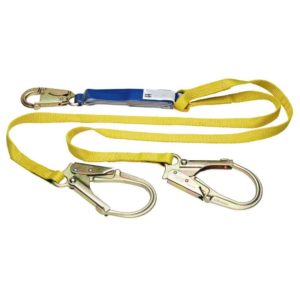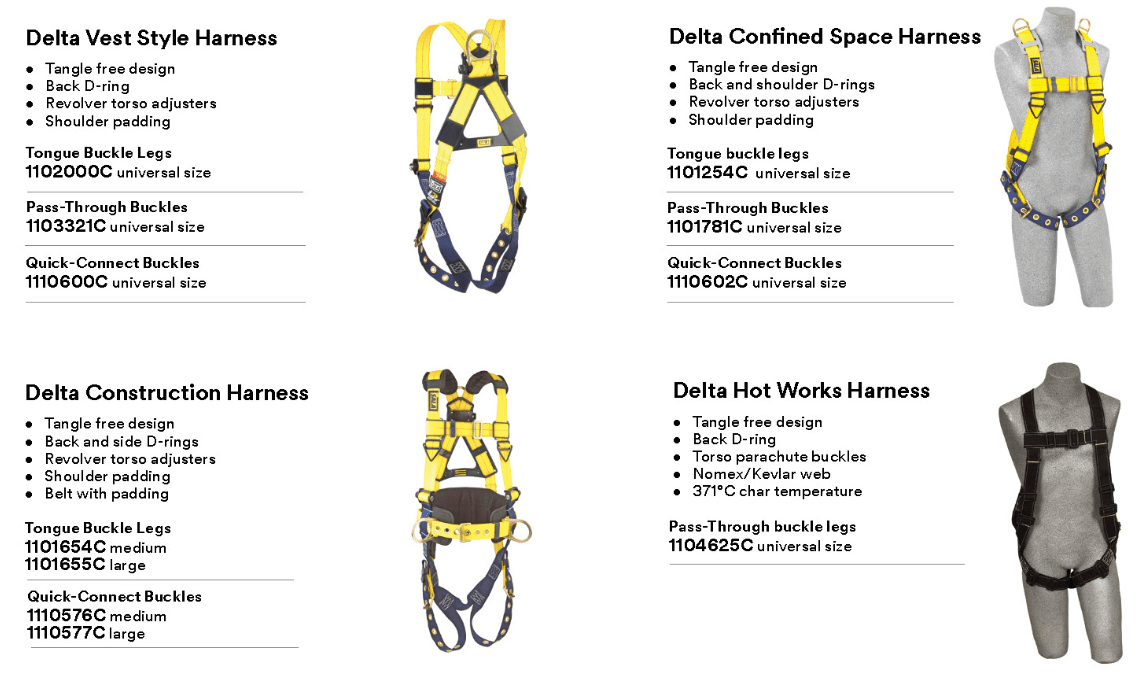7 Common Misuses Of Fall Protection Equipment
7 Common Misuses Of Fall Protection Equipment
Every worker has the right to return home safe each and every day. The most recent report conducted by the Canadian Centre for Occupational Health and Safety (CCOHS), showed that 251,508 Canadian’s accepted claims for lost time due to work-related injury or disease in just one year.
Did you know that approximately 18% of those time-loss injuries, or about 42,000 workers a year, are injured due to fall incidents alone? You can prevent falls and incidents like these by wearing proper fall protection equipment, and wearing it right.
If you’re working at a height exceeding 3 meters (10 feet) occupational health and safety laws generally require fall protection measures to be in place. You can check with your jurisdiction as requirements do vary, but in most cases fall protection measures such as fixed barriers, surface opening protections, control zones, fall or travel restraint systems, fall containment systems or fall arrest systems are required. You can learn more about some of these systems by reading our fall protection glossary.
But it’s not good enough just to throw on the required minimum fall protection equipment and call it a day – It’s important the equipment be used properly.
In this blog, we will be talking a bit about 7 common misuses of fall
protection equipment, to serve as a reminder for things to look out
for, but should be used in conjunction with proper training. The Hercules Training Academy offers an extensive suite of high-quality safety training and certification courses, including a course on fall protection!
1. Misuse of Rebar Snap Hooks
Rebar hooks (also referred to as pelican hooks, large gates or form hooks) are frequently used pieces of equipment in the fall protection world because their large openings make them quick and easy to use. They also allow for connection to many objects, eliminating the need for additional anchorage connectors. However, not using an additional connector can be very dangerous in the wrong circumstances and rebar hooks are only approved for specific configurations so if you use them outside of those configurations, it can present a safety hazard to workers.
The best way to mitigate the misuse of rebar snap hooks is to ensure that the anchorage connector D-ring is larger than the snap hook to avoid side loading. Since this is difficult to achieve, oftentimes workers choose to use a small anchor strap instead with some workplaces not allowing the use of snap hooks all together!
2. Misuse of Lanyards
A common mistake made with lanyards is users wrapping them back upon themselves. Most fall arrest lanyards are not designed to wrap around a structure and hook onto themselves, but a worker may try to set it up in that way if no other anchorage point is available. This can cause equipment failure due to damaged to the lanyard material or improper gate loading. This problem can be solved with anchorage straps, which are designed to be wrapped back on themselves – providing the proper strength needed to be safe while also remaining accessible.
Furthermore, regardless of if a lanyard is designed for wrapping around beams, piping, ductwork, or around a guardrail, with time, the sawing action could damage it. This problem can be mitigated by using a beam clamp or beam straps as an anchorage connector.
3. Inappropriate Anchorage Connection or Strength
A fall protection system is only as effective as its anchorage. Always ensure the anchorage is strong enough to support the weight of the individual wearing it in the case of a fall. To be sure you can rely on your fall protection equipment, always test the strength of the connection after set up.
To be certain you have the right anchorage strength, only use certified anchorages and make sure there is always someone on the scene with the correct training to properly identify the appropriate anchorage to use for the circumstances of the job. Since the average weight of the individuals using the fall protection system will very, the anchorage system must be designed for the maximum weight of any potential users.

4. Anchoring Below The Dorsal D-Ring
Another common misuse of fall protection systems is workers anchoring themselves to a point below their dorsal D-Ring (sometimes even below their feet). This increases the free fall weight and distance, sometimes beyond the equipment’s ability to arrest it. Pushing these limits can cause the lanyard or anchorage to fall, or can exceed the allowable force on the body, which can increase the likelihood of a serious injury.
The goal is always to minimize free-fall distances, so connecting to a point above the dorsal D-ring should be the choice if in any way possible. However, if there is no overhead structure to provide an anchorage point, the worker must use a free-fall lanyard that is approved for the greater free-fall distance and force.
5. Unproperly Adjusted Harnesses
For fall protection equipment to be used correctly and effectively, workers must be wearing their equipment correctly. Most fall protection harnesses are designed with adjustable leg, waist, shoulder, and chest straps, which all must be sized to the user. A fall protection system is no good if you can’t stay in it, which is exactly the risk presented if the harness is not tightened properly to the user’s body. As you can imagine, being ejected from a harness mid-fall can lead to serious injury.

Here’s what to look for to ensure a harness is fitted correctly:
- The dorsal D-ring sits between the worker’s shoulders blades – If it’s adjusted too high, the metal hardware could cause injury to the user’s head and if it’s adjusted too low, the user can be left hanging in a poor position with an increased risk of suspension trauma.
- The chest strap should lie across the user’s chest at the base of the sternum – If it’s too high on the user’s chest, it can cause a choking hazard in the case of a fall by putting pressure on the user’s neck.
- Shoulder straps cannot be pulled off of the user’s shoulders or outward.
- Sub-pelvic straps are positioned under the buttocks.
- Leg straps are tightened to a point where four fingers can fit between the strap and the user’s leg, but cannot pull away from the leg.
- General observation of harness fit – Looking for things like twisted straps or asymmetrical leg straps.
6. Using Damaged or Recalled Equipment
Everything from UV exposer, corrosion, wear and tear and everything in between can impact the effectiveness of your fall protection equipment. You can avoid UV and corrosion damage by storing your equipment properly when not in use, but some amount of wear and tear cannot be avoided if you’re actually using your equipment, which is what it’s made for after all! Because of this, all users should be trained on what to look for when inspecting equipment to ensure that it is in proper working order to operate safely.
Steps to ensure your equipment is always in safe working condition:
- Have your equipment inspected on at least an annual basis – Another thing Hercules SLR’s experienced and LEEA certified team can take off your hands!
- Register your equipment so you are always notified of product recalls or advisories.
- Stay current on advisories and advances in technology.
- Store equipment in an environment that is as protected as possible.
7. Confusing Twin-Leg Energy-Absorbing & Self-Retracting Devices
Although these two devices sometimes look and function similar, a common mistake people make is thinking twin-leg energy absorbing & self-retracting lifeline devices are the same or interchangeable. However, since they are designed and tested for specific conditions, it’s important they are used for those appropriate applications.
The self-retracting lifeline (SRL) vs. energy-absorbing lifeline (EAL) is a topic of lively debate among fall protection engineers because both devices have their benefits but the general consensus is that an SRL is preferable in an industrial environment where an overhead horizontal system is (or can be) installed and an EAL is preferable in a construction environment where workers typically do not have access to an overhead anchorage point.

——————————————————————————————————————————————
The Hercules Group of Companies encompasses a wide portfolio of products and services across 7 diverse companies.


